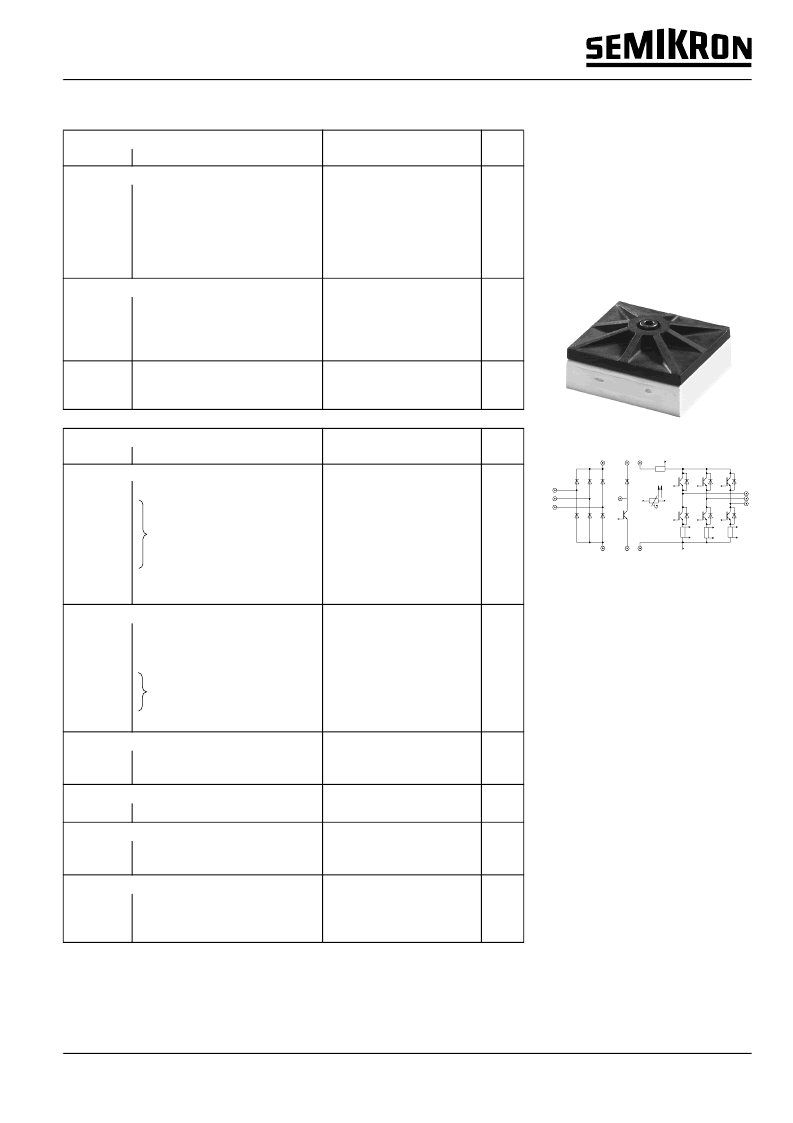- 您現(xiàn)在的位置:買賣IC網(wǎng) > PDF目錄371376 > 22NAB12 (Electronic Theatre Controls, Inc.) 3-phase bridge rectifier +braking chopper +3-phase bridge inverter PDF資料下載
參數(shù)資料
| 型號: | 22NAB12 |
| 廠商: | Electronic Theatre Controls, Inc. |
| 英文描述: | 3-phase bridge rectifier +braking chopper +3-phase bridge inverter |
| 中文描述: | 三相整流橋制動斬波器三相橋逆變器 |
| 文件頁數(shù): | 1/4頁 |
| 文件大小: | 246K |
| 代理商: | 22NAB12 |

by SEMIKRON
000131
B 16 – 53
Absolute Maximum Ratings
Symbol
Conditions
1)
Inverter & Chopper
V
CES
V
GES
I
C
I
CM
I
F
= –I
C
I
FM
= –I
CM
t
p
< 1 ms; T
heatsink
= 25 / 80 °C
Bridge Rectifier
V
RRM
I
D
I
FSM
I
2
t
t
p
= 10 ms; sin. 180 °, T
j
= 25 °C
T
j
T
stg
V
isol
AC, 1 min.
Values
Units
T
heatsink
= 25 / 80 °C
t
p
< 1 ms; T
heatsink
= 25 / 80 °C
T
heatsink
= 25 / 80 °C
1200
± 20
23 / 15
46 / 30
24 / 17
48 / 34
V
V
A
A
A
A
T
heatsink
= 80 °C
t
p
= 10 ms; sin. 180 °, T
j
= 25 °C
1500
25
700
2400
V
A
A
A
2
s
°C
°C
V
– 40 . . . + 150
– 40 . . . + 125
2500
Characteristics
Symbol
IGBT - Inverter & Chopper
V
CEsat
t
d(on)
t
r
t
d(off)
t
f
E
on
+ E
off
C
ies
R
thjh
per IGBT
Diode
2)
- Inverter & Chopper
V
F
= V
EC
V
TO
r
T
I
RRM
Q
rr
E
off
R
thjh
per diode
Diode - Rectifier
V
F
R
thjh
per diode
Temperature Sensor
R
TS
T = 25 / 100 °C
Shunts (SKiiP 22 NAB 12 I)
R
cs(dc)
R
cs(ac)
1 %
Mechanical Data
case to heatsink, SI Units
mechanical outline see page
B 16 – 8
Conditions
1)
min.
typ.
max.
Units
I
C
= 15 A
T
j
= 25 (125)
°
C
V
CC
= 600 V; V
GE
= ± 15 V
I
C
= 15 A; T
j
= 125
°
C
R
gon
= R
goff
= 82
inductive load
V
CE
= 25 V; V
GE
= 0 V, 1 MHz
–
–
–
–
–
–
–
–
2,5(3,1)
55
45
400
70
4,0
1,0
–
3,0(3,7)
110
90
600
100
–
–
1,4
V
ns
ns
ns
ns
mJ
nF
K/W
I
F
= 15 A
T
j
= 125 °C
T
j
= 125 °C
I
F
= 15 A, V
R
= – 600 V
di
F
/dt = – 400 A/
μ
s
V
GE
= 0 V, T
j
= 125 °C
T
j
= 25 (125)
°
C
–
–
–
–
–
–
–
2,0(1,8)
1,0
53
16
2,7
0,6
–
2,5(2,3)
1,2
73
–
–
–
1,7
V
V
m
A
μ
C
mJ
K/W
I
F
= 35 A, T
j
= 25 °C
–
–
1,2
–
–
1,6
V
K/W
1000 / 1670
5 %
4)
16,5
10
m
m
M
1
Case
2
–
M2
2,5
Nm
SKiiP 22 NAB 12 - SKiiP 22 NAB 12 I
MiniSKiiP 2
SEMIKRON integrated
intelligent Power
SKiiP 22 NAB 12
SKiiP 22 NAB 12 I
3)
3-phase bridge rectifier +
braking chopper +
3-phase bridge inverter
Case M2
UL recognized file no. E63532
specification of shunts and
temperature sensor see part A
common characteristics see
page B 16 – 4
1)
T
heatsink
= 25 °C, unless
otherwise specified
2)
CAL = Controlled Axial Lifetime
Technology (soft and fast
recovery)
3)
With integrated DC and/or AC
shunts
4)
accuracy of pure shunt, please
note that for DC shunt no
separate sensing contact is
used.
相關(guān)PDF資料 |
PDF描述 |
|---|---|
| 22R106 | INDUCTOR 10MH |
| 22R156 | INDUCTOR 15MH |
| 22R226 | INDUCTOR 22MH |
| 22R335 | INDUCTOR 3.3MH |
| 22R336 | INDUCTOR 33MH |
相關(guān)代理商/技術(shù)參數(shù) |
參數(shù)描述 |
|---|---|
| 22NC1-440 | 制造商:GREER (SPS) 功能描述: |
| 22NC2-04 | 制造商:Esna Technologies 功能描述: |
| 22NC2-62 | 制造商:Esna Technologies 功能描述: |
| 22NC2-632 | 制造商:GREER (SPS) 功能描述: |
| 22NC3-02 | 制造商:Esna Technologies 功能描述: |
發(fā)布緊急采購,3分鐘左右您將得到回復(fù)。